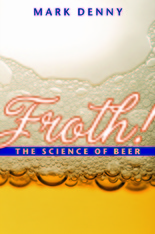
Johns Hopkins University Press
Hardback, $24.95, 200 pp
In spite of its very technical production and perceived alchemic mystery, beer should be lightly thought-provoking and imminently enjoyable. But it is hard for the scientifically inclined to not be intrigued by the goings-on in both the complexity of brewing and a simple glass of beer. In that vein, beer books often come across as rather deadpan. Enter homebrewer and physicist Mark Denny, author of Froth! The Science of Beer, whose curiosity, passion and wit bring us a light-hearted take on the history, brewing and science of beer.
This is not yet another homebrewing instructional manual with recipes, nor is it an in-depth thesis on the minutiae of brewing science. It is an account of brewing history and the major geographical categories of beer and a layman’s unraveling of its science. The first portion of the book is devoted to tracing a brief evolution of brewing, from the prehistoric and evidential Genesis of the Fertile Crescent some 10,000 years ago, to the gradual encroachment into Europe, and finally to its current global status. Nothing really new here, but Denny manages to distill all relevant events of brewing annals in concise and humorous fashion.
Section Two, “How to Make Good Beer at Home,” is a simplified and thorough skeleton tutorial on the production of a simple batch of step-mashed grain and sugar-augmented ale fermented with dried yeast followed by fermentation and bottling. Overall, there is enough technical advice and information to ensure a successful brew from batch one. Though this is rudimentary to most homebrewers, the basic recipe and method are valuable enough to encourage the beginning hobbyist. Certainly, there are more extensive resources elsewhere, but Denny’s point is one of utilitarian, simplistic understanding of the process. Again, his delivery is entertaining and amusing, with an infusion of science.
The final section of the book finds Denny delving into more intense scientific matters. Topics include yeast population dynamics, brewing thermodynamics, bubbles and fluid flow. This is perhaps not for the casual beer fan, but contained within the numerous equations and technical details is useful information to those who endeavor to brew more intently, or earn a living in the industry. To the amateur, it might simply satisfy scientific curiosity, as Denny sheds light on these mundane subjects as others likely cannot. The book finishes with a few pages on the most important aspect of all regarding beer, the pure pleasure of enjoying a glass of well-made brew.
Overall, Froth! is a fairly entertaining read, though definitely not for everyone. I suspect, however, that there is a sizable niche of beerdom looking for something a bit different… and Denny’s glib tome is that.









